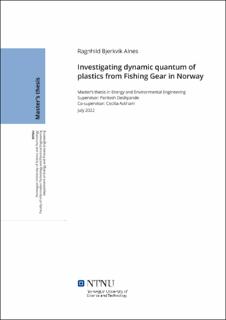| dc.contributor.advisor | Deshpande, Paritosh | |
| dc.contributor.advisor | Askham, Cecilia | |
| dc.contributor.author | Alnes, Ragnhild Bjerkvik | |
| dc.date.accessioned | 2022-11-01T18:20:00Z | |
| dc.date.available | 2022-11-01T18:20:00Z | |
| dc.date.issued | 2022 | |
| dc.identifier | no.ntnu:inspera:110284204:32430546 | |
| dc.identifier.uri | https://hdl.handle.net/11250/3029442 | |
| dc.description.abstract | Denne oppgaven tar for seg massestømmene av plast i fiskeutstyr i det kommersielle fisket i Norge for 2016 til 2020. Mengdene fiskeutstyr er utregnet ved massestrømsanalyse (MFA) og dataen er fra tilgjengelig litteratur, salgsdata over fiskeutstyr og data fra avfallsselskap, statistikk over innsamlet fiskeutstyr fra hav og stand og en spørreundersøkelse av avfallsselskap.
Det er nyttig å tallfeste mengden fiskeutstyr i industrien, havet og i bruk for å videre kunne gjøre en vurdering av de miljømessige konsekvensene til fiskeriet, gjennom for eksempel livssyklusanalyse (LCA). Konsekvensene av tapt fiskeutstyr er mange, deriblant spøkelsesfiske, innvikling, transport av miljøgifter til arter via plastbiter og ved inntak av plastbiter kan det føre til; sult som følge av blokkering eller følelse av metthet, skade på organer og i verste fall død for marine arter.
I 2020 ble det mistet 425 tonn plast i form av fiskeutstyr i det kommersielle fisket, og 134 tonn ble tatt ut av havet og kystnære strøk. Teiner har størst tap av plast per fangst, mens snurpenot har minst tap per fangst. Det er mest totalt tap fra snurrevad, selv om de har det nest største tapet på1.17kg plast per tonn rundvekt. Trål har lite tap per fangst, men siden nær halvparten av fangsten er fanget med trål er trålfisket det som har nest mest plastutslipp i Norge totalt i 2020.
Oppgavens nye bidrag, utstyrsspesifik plasttap per fangst, kan sammen med årlige fangstdata brukes som en dynamisk faktor for å anslå fiskeutstyrstap for 2000 til 2021 og fremover i tid. | |
| dc.description.abstract | This thesis is on the mass flows of plastic in fishing equipment in commercial fishing in Norway from 2016 to 2020. The quantities of fishing equipment are calculated by material flow analysis (MFA) and the data are from available literature, sales data on fishing equipment and data from waste companies, statistics collected on fishing equipment from sea and land, and a survey of waste companies.
It is useful to quantify the amount of fishing equipment in the industry, the sea and in use in order to further assess the environmental consequences of fishing, by, for example, life cycle assessment (LCA). The consequences of lost fishing gear are many, including ghost fishing, entanglement, transport of environmental toxins to species via plastic pieces and ingesting plastic pieces, which can lead to; starvation due to blockage or feeling of satiety, damage to organs and in the worst-case death of marine species.
In 2020, 425 tonnes of plastic were lost in the form of fishing equipment in commercial fishing, and 134 tonnes were retrieved from the sea and coastal areas. Pots have the largest loss of plastic per catch, while purse seines have the least loss per catch. The highest loss is from Danish seines, even though they have the second-largest loss of 1.17 kg of plastic per tonne of round weight. Trawls have little loss per catch, but since almost half of the catch is caught with trawls, trawl fishing is the second most lost in total for Norway in 2020.
The thesis’ new contribution, equipment-specific plastic loss per catch, can be used together with annual catch data as a dynamic factor to estimate fishing equipment losses from 2000 to 2021 and for the future. | |
| dc.language | eng | |
| dc.publisher | NTNU | |
| dc.title | Investigating dynamic quantum of plastics from Fishing Gear in Norway | |
| dc.type | Master thesis | |
